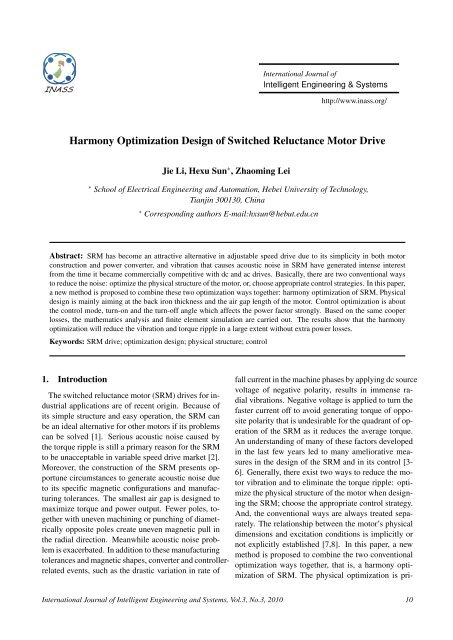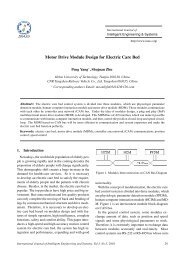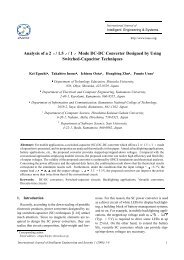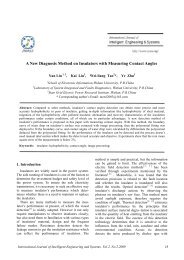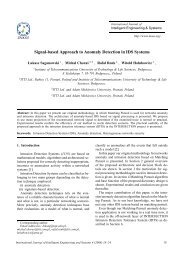Harmony Optimization Design of Switched Reluctance Motor ... - inass
Harmony Optimization Design of Switched Reluctance Motor ... - inass
Harmony Optimization Design of Switched Reluctance Motor ... - inass
Create successful ePaper yourself
Turn your PDF publications into a flip-book with our unique Google optimized e-Paper software.
International Journal <strong>of</strong><br />
Intelligent Engineering & Systems<br />
http://www.<strong>inass</strong>.org/<br />
<strong>Harmony</strong> <strong>Optimization</strong> <strong>Design</strong> <strong>of</strong> <strong>Switched</strong> <strong>Reluctance</strong> <strong>Motor</strong> Drive<br />
Jie Li, Hexu Sun ∗ , Zhaoming Lei<br />
∗ School <strong>of</strong> Electrical Engineering and Automation, Hebei University <strong>of</strong> Technology,<br />
Tianjin 300130, China<br />
∗ Corresponding authors E-mail:hxsun@hebut.edu.cn<br />
Abstract: SRM has become an attractive alternative in adjustable speed drive due to its simplicity in both motor<br />
construction and power converter, and vibration that causes acoustic noise in SRM have generated intense interest<br />
from the time it became commercially competitive with dc and ac drives. Basically, there are two conventional ways<br />
to reduce the noise: optimize the physical structure <strong>of</strong> the motor, or, choose appropriate control strategies. In this paper,<br />
a new method is proposed to combine these two optimization ways together: harmony optimization <strong>of</strong> SRM. Physical<br />
design is mainly aiming at the back iron thickness and the air gap length <strong>of</strong> the motor. Control optimization is about<br />
the control mode, turn-on and the turn-<strong>of</strong>f angle which affects the power factor strongly. Based on the same cooper<br />
losses, the mathematics analysis and finite element simulation are carried out. The results show that the harmony<br />
optimization will reduce the vibration and torque ripple in a large extent without extra power losses.<br />
Keywords: SRM drive; optimization design; physical structure; control<br />
1. Introduction<br />
The switched reluctance motor (SRM) drives for industrial<br />
applications are <strong>of</strong> recent origin. Because <strong>of</strong><br />
its simple structure and easy operation, the SRM can<br />
be an ideal alternative for other motors if its problems<br />
can be solved [1]. Serious acoustic noise caused by<br />
the torque ripple is still a primary reason for the SRM<br />
to be unacceptable in variable speed drive market [2].<br />
Moreover, the construction <strong>of</strong> the SRM presents opportune<br />
circumstances to generate acoustic noise due<br />
to its specific magnetic configurations and manufacturing<br />
tolerances. The smallest air gap is designed to<br />
maximize torque and power output. Fewer poles, together<br />
with uneven machining or punching <strong>of</strong> diametrically<br />
opposite poles create uneven magnetic pull in<br />
the radial direction. Meanwhile acoustic noise problem<br />
is exacerbated. In addition to these manufacturing<br />
tolerances and magnetic shapes, converter and controllerrelated<br />
events, such as the drastic variation in rate <strong>of</strong><br />
fall current in the machine phases by applying dc source<br />
voltage <strong>of</strong> negative polarity, results in immense radial<br />
vibrations. Negative voltage is applied to turn the<br />
faster current <strong>of</strong>f to avoid generating torque <strong>of</strong> opposite<br />
polarity that is undesirable for the quadrant <strong>of</strong> operation<br />
<strong>of</strong> the SRM as it reduces the average torque.<br />
An understanding <strong>of</strong> many <strong>of</strong> these factors developed<br />
in the last few years led to many ameliorative measures<br />
in the design <strong>of</strong> the SRM and in its control [3-<br />
6]. Generally, there exist two ways to reduce the motor<br />
vibration and to eliminate the torque ripple: optimize<br />
the physical structure <strong>of</strong> the motor when designing<br />
the SRM; choose the appropriate control strategy.<br />
And, the conventional ways are always treated separately.<br />
The relationship between the motor’s physical<br />
dimensions and excitation conditions is implicitly or<br />
not explicitly established [7,8]. In this paper, a new<br />
method is proposed to combine the two conventional<br />
optimization ways together, that is, a harmony optimization<br />
<strong>of</strong> SRM. The physical optimization is pri-<br />
International Journal <strong>of</strong> Intelligent Engineering and Systems, Vol.3, No.3, 2010 10
marily aiming at the back iron thickness b s and the<br />
air gap length l g . The relationships between back iron<br />
thickness and the motor’s natural frequency, air gap<br />
length and the radial force are analyzed; the motor’s<br />
output torque and the radial forces with variation dimension<br />
are simulated by using finite element s<strong>of</strong>tware.<br />
And on the basis <strong>of</strong> these physical design analyses,<br />
control modes <strong>of</strong> the SRM including single phase<br />
excited, and the double phase excited and appropriate<br />
control strategy including the turn-on and turn-<strong>of</strong>f<br />
angle are discussed under either the PWM operations<br />
or current limited control. The best switching point is<br />
selected with reference to a suitable motor dimension;<br />
it is approved that harmony optimization will reduce<br />
the vibration and torque ripple in a large extent without<br />
extra power losses. This work lays the foundation<br />
<strong>of</strong> designing higher performance <strong>of</strong> the SRM drive.<br />
Figure 1. General design optimization process for SRM<br />
2. SRM physical dimension parametric analysis<br />
The construction <strong>of</strong> the SRM presents opportune circumstances<br />
to generate acoustic noise due to its specific<br />
magnetic configurations and manufacturing tolerances.<br />
A qualitative design measures can be implemented<br />
at the design stage <strong>of</strong> SRM to reduce the<br />
noise effectively. The general optimization process<br />
adopted for SRM has been illustrated well by Tang<br />
[9] and is shown in Fig.1. And, the physical optimization<br />
design <strong>of</strong> switched reluctance machine has<br />
been attempted under the following categories: shape<br />
modification through choice <strong>of</strong> geometrical parameters;<br />
deterministic methods; s<strong>of</strong>t computing methods.<br />
Performance analysis <strong>of</strong> the SRM requires the dimensions<br />
for stator and rotor laminations, winding details,<br />
pole numbers, and pole arcs. An approximate<br />
sizing <strong>of</strong> the SRM is obtained using a power out put<br />
equation and the resulting machine dimensions form<br />
the starting point in optimization design analysis. Here,<br />
the dimension parametric analysis is employed and<br />
the performance <strong>of</strong> the prototype motor in finite element<br />
s<strong>of</strong>tware Maxwell 2D package is calculated.<br />
As the Static characteristics form the foundation <strong>of</strong><br />
motor design, in order to obtain static magnetization<br />
characteristics, it is assumed that an ideal square current<br />
pulse applied, the motor’s speed is sufficiently<br />
low and the SRM with one phase excited at any rotor<br />
position.<br />
The entire excitation cycle is 60 o and the phase current<br />
conduction period is 30 o . The excitation sequence<br />
in the four-phase motor is shown in Fig. 2. Phase current<br />
pulse is used as abscissa; rotor position is used as<br />
Figure 2. Excitation sequences in motor<br />
coordinates [10].<br />
The dimensions parameters discussed here are mainly<br />
about the back iron thickness b s , air gap l g , and other<br />
relevant dimensions including the stator outer diameter<br />
D s , stator pole height H s , rotor outer diameter γ,<br />
stator pole width ω sp . The relevant dimensions <strong>of</strong> the<br />
SRM are shown in Fig. 3.<br />
2.1 Back iron thickness parametric analysis<br />
It is critical to know the frequencies at which various<br />
components <strong>of</strong> the radial force frequencies coincide<br />
with the natural frequency <strong>of</strong> the machine to generate<br />
resonance, leading to an increase in the acoustic<br />
noise. The stator <strong>of</strong> the machine has its own natural<br />
frequency. And similar to other machines, the<br />
SRM has radial forces producing vibrations that result<br />
in acoustic noise. This is mostly at the fundamental<br />
mode frequency <strong>of</strong> the SRM structure. If the phase<br />
frequency or its odd harmonics coincide with that <strong>of</strong><br />
the SRM, then a resonance occurs, resulting in peak-<br />
International Journal <strong>of</strong> Intelligent Engineering and Systems, Vol.3, No.3, 2010 11
Figure 3. Relevant dimensions <strong>of</strong> the SRM<br />
ing <strong>of</strong> stator vibration. The phase frequency is:<br />
f p = ( ω 2π )P r (1)<br />
Where ω m is the speed in rads/sec and P r is the number<br />
<strong>of</strong> rotor poles. Vibration is maximum if any <strong>of</strong> the<br />
frequencies,<br />
f n = n f p ,n = 1,3,5,7,... (2)<br />
are coincident with the natural frequency f <strong>of</strong> the stator.<br />
Vibrations seem to diminish for even harmonics<br />
<strong>of</strong> phase frequency coinciding with natural frequency<br />
f <strong>of</strong> the SRM structure. Then, to control the acoustic<br />
noise, the natural mode frequency <strong>of</strong> the motor has to<br />
be evaluated [11,12].<br />
Assuming the stator lamination stack as a uniform<br />
cylindrical shell, whose thickness is b s , that is the back<br />
iron thickness, and the stack length is L. When a vertical<br />
load w is applied on this ring structure, a deflection<br />
result makes the ring distort into an ellipse. Due to the<br />
load application, the potential energy must be equal<br />
to the kinetic energy arising out <strong>of</strong> the deflection for<br />
energy conservation <strong>of</strong> the structure. From this, the<br />
angular natural frequency can be obtained as:<br />
ω 2 =<br />
2<br />
12π(1 − γ 2 )( π 4 − 2 π )(E ρ )(b2 s<br />
ry<br />
4 ) (3)<br />
where γ is the poisson ratio, ρ is the mass density<br />
<strong>of</strong> the material, γ y is the geometric mean radius <strong>of</strong> the<br />
stator shell, E is the modulus <strong>of</strong> elasticity [13,14].<br />
From Eqs.(1) and (3), it can be seen that the fundamental<br />
mode frequency is primarily influenced by<br />
back iron thickness and to a lesser extent by the outer<br />
diameter <strong>of</strong> the stator lamination. For that, when we<br />
design a SRM, the outer diameter <strong>of</strong> the motor is always<br />
a constant for a given power and speed in industrial<br />
production. This leaves the back iron thickness<br />
as an important design parameter.<br />
From Eq.(3), it is obvious that a higher thickness is<br />
favorable as it increases the first mode frequency, thus<br />
the resonance which results in peaking <strong>of</strong> stator vibration<br />
can be avoid effectively. Also, a higher thickness<br />
gives higher mechanical strength which restrains<br />
the stator’s distortion caused by the radial force. The<br />
penalty <strong>of</strong> a higher thickness then is a large back iron<br />
thickness that increases the weight, current density<br />
and copper losses but reduces the available area for<br />
windings. In the design process a trade<strong>of</strong>f has to be<br />
achieved. The stator back iron thickness b s is based on<br />
the maximum flux density in it and by the additional<br />
factor <strong>of</strong> vibration minimization to reduce acoustic<br />
noise. Always, b s has a value in the range <strong>of</strong>:<br />
ω s p > b s ≥ 0.5ω s p (4)<br />
To dig the relationship between the back iron thickness<br />
and output performance <strong>of</strong> a SRM, a finite element<br />
model <strong>of</strong> the prototype motor is created in Maxwell<br />
2D package. The motor’s specifications are given in<br />
Table 1.<br />
Table 1. Specifications <strong>of</strong> SRM prototype<br />
Item<br />
Prototype<br />
No. <strong>of</strong> phase 4<br />
No. <strong>of</strong> stator/rotor poles 8/6<br />
Stator outer diameter[mm] 145<br />
Rotor outer diameter[mm] 79.5<br />
Back iron thickness[mm] 14<br />
Stator pole arc[degree] 21<br />
Rotor pole are[degree] 24<br />
Air-gap length[mm] 0.25<br />
Winding (turns per pole) 72<br />
Rated torque (N.m) 7<br />
The motor is excited in one phase current conduction<br />
period 30 o with an ideal square current pulse as<br />
seen in Fig.2. The back iron thickness <strong>of</strong> the motor<br />
is varied from ω sp to 0.5ω sp with an equal interval <strong>of</strong><br />
2mm. This variation <strong>of</strong> back iron thickness results in<br />
a corresponding change in the stator pole height while<br />
there are enough space for the winding arrangement.<br />
Other parameters <strong>of</strong> the motor are held constant.<br />
Fig.4. is the parametric analysis setup in the s<strong>of</strong>tware,<br />
where the initial dimension <strong>of</strong> the b s is 14mm.<br />
And with an equal interval <strong>of</strong> 2mm, b s changes from<br />
14mm to 7mm. Fig.5. is the family curves <strong>of</strong> output<br />
International Journal <strong>of</strong> Intelligent Engineering and Systems, Vol.3, No.3, 2010 12
. Let r be the outer radius <strong>of</strong> the rotor, L be the stack<br />
length or iron length in the z direction, T ph be the<br />
number <strong>of</strong> turns in one phase <strong>of</strong> the machine, i be<br />
the current in the winding, Hg be the magnetic field<br />
strength, Φ be the flux, and µ 0 be the permeability <strong>of</strong><br />
air, then the variables are derived as:<br />
Figure 4. Parametric analysis setup<br />
B g (θ,l g ,i) =<br />
Φ<br />
Lrθ = µ T ph i<br />
0H g = µ 0 (5)<br />
l g<br />
T ph i =<br />
l g Φ<br />
µ 0 Lr θ<br />
(6)<br />
The incremental electrical input energy dWe is given<br />
by:<br />
dw e = idλ = id(T ph Φ) = T ph idΦ =<br />
l g Φ<br />
dΦ (7)<br />
µ 0 Lr θ<br />
The stored energy in the magnetic field dWs is<br />
W s = l gLrθ<br />
B 2<br />
2µ<br />
g(θ,l g .i) = l g Φ 2<br />
0 2µ 0 rL θ<br />
(8)<br />
Figure 5. Static torque versus rotor position curves<br />
torque with different back iron thickness, where the<br />
simulation result illustrates that a bigger b s tends to<br />
increase the motor’s output and that the b s not only<br />
affects the torque output but also controls the shape<br />
<strong>of</strong> the static torque pr<strong>of</strong>ile. A curve colors red has a<br />
departure when the stator back iron thickness b s is too<br />
small thus the stator yoke is heavily saturated. In this<br />
case a flatter torque versus angle characteristic may be<br />
achieved by compromising the back iron thickness.<br />
2.2 Air gap length parametric analysis<br />
Air gap length is an important design parameter <strong>of</strong><br />
SRM. The magnetic flux in the machine passes across<br />
the air gap in an approximate radial direction producing<br />
radial forces on the stator and rotor, resulting in<br />
magnetic noise and vibrations. The radial forces in<br />
the SRM are directly proportional to the square <strong>of</strong> the<br />
flux density in the air gap, assuming that the iron is<br />
infinitely permeable and has zero reluctance which<br />
leaves only the air gap to provide reluctance in the<br />
circuit.<br />
The air gap flux density at a given stator and rotor<br />
pole overlap angle θ, air gap lg, and current i is given<br />
as<br />
b g (θ,l g ,i)<br />
where the term l g Lrθ gives the volume <strong>of</strong> the air<br />
gap contained by the stator and rotor pole overlap.<br />
Note that rθ gives the arc <strong>of</strong> the overlapping region<br />
between the stator and rotor poles. The energy balance<br />
equation neglecting losses is:<br />
dW e = dW s + dW m (9)<br />
where dWm is the incremental mechanical energy<br />
and dWs is the incremental field energy. To find the<br />
tangential, radial, and lateral forces, note that the incremental<br />
field energy for that directional variable has<br />
to be taken and substituted in Eq.(9). As the electrical<br />
input energy is given in Eq.(7), the mechanical energy<br />
is computed by subtracting the incremental field energy<br />
from the incremental input energy [15-17].<br />
The incremental field energy is obtained from Eq.(8)<br />
as:<br />
dW s =<br />
l g Φ 2<br />
2µ 0 Lr θ 2 dθ +<br />
l g<br />
µ 0 Lr<br />
Φ<br />
dΦ (10)<br />
θ<br />
The second term on the right side <strong>of</strong> Eq.(10) is based<br />
on the fact that Φ is the air gap flux density and that it<br />
is a function <strong>of</strong> rotor position, l g and i.<br />
Substitute Eqs.(7) and (10) in Eq.(9), the incremental<br />
mechanical energy is obtained as:<br />
dW m =<br />
l g Φ 2<br />
dθ (11)<br />
2µ 0 Lr θ 2<br />
International Journal <strong>of</strong> Intelligent Engineering and Systems, Vol.3, No.3, 2010 13
Then the tangential torque is obtained as:<br />
T e = dW m<br />
dθ = l g Φ 2<br />
2µ 0 Lr θ 2 = l grL<br />
B 2<br />
2µ<br />
g(θ,l g ,i) (12)<br />
0<br />
Therefore, the tangential force is obtained by dividing<br />
the tangential torque by the radius <strong>of</strong> the rotor<br />
pole, yielding:<br />
F t = T e<br />
r = l gL<br />
2µ 0<br />
B 2 g(θ,l g ,i) (13)<br />
The radial force in the direction <strong>of</strong> the air gap is obtained<br />
from considering the incremental field energy<br />
with respect to the air gap and the incremental mechanical<br />
energy as:<br />
Figure 6. Radial forces versus rotor position curves<br />
dW m = − 1 Φ 2<br />
2µ 0 rL θ dl g (14)<br />
and the radial force is :<br />
F n = dW m<br />
dl g<br />
= − 1<br />
2µ 0<br />
. Φ θ = −rµ 0Lθ.T 2 ph .i2<br />
2l 2 g<br />
Similarly, the lateral force can be derived as:<br />
(15)<br />
F y = l grθ<br />
2µ 0<br />
B 2 g(θ,l g ,i) (16)<br />
From the equations above, it can be stated that lateral<br />
force and tangential force are <strong>of</strong> similar magnitude<br />
but the radial force is not. From Eqs.(13) and<br />
(15), the ratio between the radial force and tangential<br />
force is:<br />
F n<br />
F t<br />
= − rθ<br />
l g<br />
(17)<br />
The rotor angle can be assumed to be equal to the<br />
one-phase conduction angle which in terms <strong>of</strong> the rotor<br />
and stator poles is given as:<br />
θ = 4π<br />
P s P r<br />
(18)<br />
where P S and P r are the number <strong>of</strong> stator and rotor<br />
poles.<br />
From the analytical expression, an obvious way to<br />
reduce noise would be to reduce the flux density by<br />
enlarging the air gap. Also a larger air gap is preferred<br />
from the manufacturing points <strong>of</strong> view. It is<br />
clear that a large air gap length is preferred in a reasonable<br />
range.<br />
Figure 7. Static torque versus rotor position curves<br />
Again, a finite element model <strong>of</strong> the prototype motor<br />
is created in Maxwell 2D package. The specification<br />
<strong>of</strong> the motor is given in Table 1. In one conduction<br />
period 30 o , the ideal square current pulse is applied<br />
to one phase winding. The motor’s radial force<br />
and the output torque with a series air gap value are<br />
calculated with the same current.<br />
Considering the mechanical robustness and the minimization<br />
<strong>of</strong> vibration, the air gap could have a value<br />
in the range <strong>of</strong> 0.25 to 0.5. Fig.6 and Fig.7 are the<br />
family curves <strong>of</strong> radial forces and the output torque<br />
with variation <strong>of</strong> air gaps.<br />
Fig. 6 is the family curves <strong>of</strong> radial forces versus<br />
rotor position. It can be seen that radial force is a<br />
large magnitude value <strong>of</strong> thousands Newton. As the<br />
air gap increases from 0.25mm to 0.5mm, the radial<br />
force reduces from 23.3kN.m to 19.2KN.m. The drop<br />
<strong>of</strong> radial force gradually grows as the rotor pole rotates<br />
to the aligned position. At the aligned position<br />
particularly, the motor with a 0.5mm air gap could<br />
reduce 400N.m (almost 20%) radial force compared<br />
with a 0.25mm air gap length. In this way, the stator’s<br />
distortion can be mitigated effectively. But notice<br />
that the smallest air gap can maximize the torque<br />
and the power output <strong>of</strong> the motor. Fig.7 compares<br />
the static torque produced by the motor with different<br />
International Journal <strong>of</strong> Intelligent Engineering and Systems, Vol.3, No.3, 2010 14
air gap length. The static torque rises from 8.2N.m<br />
to 10.8N.m when air gap decreases from 0.5mm to<br />
0.25mm. In this case, it is necessary to make a trade<strong>of</strong>f<br />
according to the practical needs.<br />
3. <strong>Harmony</strong> optimization <strong>of</strong> physical design<br />
and control strategy <strong>of</strong> SRM<br />
Conventional control category <strong>of</strong> the SRM is either<br />
the single phase excited mode or the double phase excited<br />
mode under either the PWM operations or current<br />
limited control [18]. The double phase excited<br />
mode is always used in the odd phase circuit. Comparing<br />
with the single phase excited mode, the advantage<br />
<strong>of</strong> the double phase excited mode can make<br />
a significant improvement in torque production and a<br />
reduction in torque ripple to the motor. But considering<br />
the commutation freewheeling <strong>of</strong> current in the<br />
windings, part <strong>of</strong> the electrifying windings produce<br />
a negative torque, thus the complexity <strong>of</strong> controlling<br />
loops increases [19][20]. Besides, as the rotor poles<br />
rotate to the aligned position, the high flux density in<br />
the iron will bring a significant impact on the motor:<br />
increase the motor losses and reduce the efficiency.<br />
Here, an improved double excited mode is presented<br />
which can be applied to any type <strong>of</strong> the SRM, that is,<br />
a mix-excited mode.<br />
It is known that vibration is much nearer to the aligned<br />
position comparing with the unaligned position. Turning<br />
<strong>of</strong>f before full alignment reduces vibrations. And<br />
by commutating the current before alignment, the deeply<br />
saturated stator yoke is relieved magnetically. It’s better<br />
to make a turn-<strong>of</strong>f before full alignment under double<br />
phase excited working mode.<br />
Based on the analysis in the previous section, the<br />
choice <strong>of</strong> appropriate back iron thickness and air gap<br />
with a good switching point under double phase excited<br />
working mode can extend the flat torque period<br />
and reduce the core loss. A four-phased 8/6 SRM with<br />
optimized structure working under different control<br />
mode is simulated for harmony optimization. The results<br />
<strong>of</strong> the motor’s output performance are compared<br />
in Fig. 8, Fig. 9 and Fig. 10.<br />
As shown in Fig. 8, Fig. 9, Fig. 10, the red line is<br />
the performance <strong>of</strong> one phase excited working mode<br />
with the initial motor structure, the green line is the<br />
performance <strong>of</strong> two phases excited working mode with<br />
the initial motor structure, and the blue line is the<br />
mix-excited working mode with an optimization motor<br />
structure.<br />
The harmony optimization process is: optimize the<br />
physical structure <strong>of</strong> the motor, especially aiming at<br />
Figure 8. Output torque versus speed<br />
Figure 9. Output power versus speed<br />
the air gap and back iron thickness; calculate the flux<br />
density <strong>of</strong> the aligned position with double excited<br />
mode and choose an advanced switching point based<br />
on the iron material properties point which can avoid<br />
the saturation in the iron <strong>of</strong> the yoke.<br />
It can be seen that by enlarging the air gap length<br />
to 0.35mm and the back iron thickness to 15mm, operating<br />
the machine at an optimum switching point <strong>of</strong><br />
22 o with the same excitation current under mix-excite<br />
mode, both the output torque and the output power<br />
have greatly increased. And when the motor is operated<br />
below 8000rpm, the optimized motor has the<br />
highest efficiency. In a practical motor, if a photoelec-<br />
Figure 10. Efficiency versus speed<br />
International Journal <strong>of</strong> Intelligent Engineering and Systems, Vol.3, No.3, 2010 15
tric encoder position feedback arrangement is used, a<br />
precise tiny angle resolution could be available to have<br />
the accurate switching point.<br />
4. Conclusion<br />
This paper presents a new method to optimize the<br />
SRM: a harmony optimization method which combines<br />
the physical dimension design and control strategy<br />
together. Detailed investigations and simulations<br />
have been carried out to analyze the relationships between<br />
dimensions and the motor’s output performance.<br />
Especially, discussions are focused on the air gap and<br />
the back iron thickness. It is approved that a smooth<br />
torque characteristic can be achieved by careful selection<br />
<strong>of</strong> the motor’s back iron thickness, and that the<br />
radial force <strong>of</strong> the motor can be greatly reduced if the<br />
air gap is perfect. By analyzing the different control<br />
mode, the best switching point is selected with reference<br />
to the suitable motor dimension. The simulation<br />
shows that the choice <strong>of</strong> appropriate stator back<br />
iron thickness and air gap length coupled with perfect<br />
switching point will not only reduce the vibration and<br />
torque ripple to a large extent but also improve the motor’s<br />
output performance without extra power losses.<br />
Comparing mix-excited mode with the single phase<br />
excited mode, the starting torque has increased 70%,<br />
the rated torque has increased 100%, and the output<br />
power has increased 60% at the rated speed. When<br />
the speed is less than 3800rpm, both efficiencies are<br />
equal; when the speed goes up to 3800rpm, the mixexcited<br />
mode exceeds. Comparing mix-excited mode<br />
with double excited mode, the starting torque has increased<br />
36%, the rated torque has increased 10%, and<br />
the output power has increased 20% at the rated speed.<br />
And below 7000rpm, the efficiency <strong>of</strong> the motor under<br />
mix-excited working mode is much higher. Note<br />
that all the simulations above are based on the same<br />
winding current.<br />
It is verified that the SRM performance can be improved<br />
efficiently. This method discussed in this paper<br />
lays the foundation <strong>of</strong> designing higher performance<br />
<strong>of</strong> SRM and its significant value symbolizes<br />
the real meaning <strong>of</strong> innovation.<br />
5. Acknowledgments<br />
The authors gratefully acknowledge financial support<br />
from National High Technology Research and<br />
Development 863 Program <strong>of</strong> China under Grant Number<br />
2006AA040306.<br />
References<br />
[1] Timar and P.L., Noise and Vibration <strong>of</strong> Electrical<br />
Machines, Elsevier, Amsterdam/New York, 1989.<br />
[2] Wu, C.Y. and C. Pollock, “Analysis and reduction<br />
<strong>of</strong> vibration and acoustic noise in the switched reluctance<br />
drive ”, Conf. Record, IEEE IAS Ann. Mtg.,<br />
93CH3366-2, pp.106-113, 1993.<br />
[3] Lisner, R. and L. Timar, “A new approach to electric<br />
motor acoustic noise standards and test procedures”,<br />
in IEEE Int. Electric Machines and Drives<br />
Conf. Rec., Milwaukee, WI, pp. 6.1-6.3, 1997.<br />
[4] R.Krishnan, SRM Drives: Modeling, Simulation,<br />
Analysis, <strong>Design</strong> and Application, CRC Press LLC,<br />
Florida, 2001.<br />
[5] Beno, M.Marsaline, Marimuthu, N.S., Singh, N. Albert.<br />
“Improving power factor in SRM drive system<br />
by optimizing the switching angles”, IEEE Region<br />
10 Annual International Conference, Proceedings/TENCON<br />
2008.<br />
[6] S.-H. Mao and M.-C. Tsai, ”An analysis <strong>of</strong> the optimum<br />
operating point for a SRM,” J. Magn. Magn.<br />
Mater., vol. 282, pp.53-56, 2004.<br />
[7] J. P. Hong, K. H. Ha, and J. Lee, “Stator pole and<br />
yoke design for vibration reduction <strong>of</strong> SRM,” IEEE<br />
Trans. Magn., vol. 38, no. 2, pp. 929-932, Mar. 2002.<br />
[8] J. W. Ahn, S. J. Park, and D. H. Lee, “Hybrid excitation<br />
<strong>of</strong> SRM for reduction <strong>of</strong> vibration and acoustic<br />
noise,” IEEE Trans. Ind. Elect., vol.51, no. 2, pp.<br />
374-380, Apr. 2004.<br />
[9] Y.Tang and F.A Kline, “Modeling and design optimization<br />
<strong>of</strong> switched reluctance machine by boundary<br />
element analysis and simulation,” IEEE Trans.<br />
Energy Convers., Vol.11, no. 4, pp. 673-680,<br />
Dec.1996.<br />
[10] Jie Li, Hexu Sun, “Modeling and simulation <strong>of</strong> fourphase<br />
8/6 SRM with an improved winding configuration”,<br />
Proceedings <strong>of</strong> International Conference on<br />
Computer Science and S<strong>of</strong>tware Engineering, CSSE<br />
2008, v 4, pp. 1045-1048.<br />
[11] Singal, R.K., K. Williams, and S.P. Verma, “The effect<br />
<strong>of</strong> windings, frame and impregnation upon the<br />
resonant frequencies and vibrational behavior <strong>of</strong> an<br />
electrical machine stator,” Experimental Mechanics,<br />
30, 270-280, 1990.<br />
[12] Vijayraghavan, P. and R. Krishnan, “Noise in electric<br />
machines: a review,” IEEE Trans. on Ind. Appl., Vol.<br />
35, No. 5, pp. 1007-1013, Sept. Oct., 1999.<br />
[13] Kim, K.-B., “Field analysis <strong>of</strong> low acoustic noise<br />
SRM”, IEEE Trans. on Magnetics, 33(2), pp. 2026-<br />
2029, 1997.<br />
[14] Cameron, D.E., J.H. Lang, and S.D. Umans, “The<br />
origin and reduction <strong>of</strong> acoustic noise in doubly<br />
salient variable-reluctance motors”, in IEEE Trans.<br />
on Ind. Appl.,28(6), 1250-1255, 1992.<br />
International Journal <strong>of</strong> Intelligent Engineering and Systems, Vol.3, No.3, 2010 16
[15] Colby, R.S., F.M. Mottier, and T.J.E. Miller, “Vibration<br />
modes and acoustic noise in a four-phase<br />
SRM,” in IEEE Trans. on Ind. Appl., 32(6), 1357-<br />
1364, 1996.<br />
[16] S. Ayari, M. Besbes, M. Lecrivain, and M. Gabsi,<br />
“Effects <strong>of</strong> the airgap eccentricity on the SRM vibrations,”<br />
in Proc. IEEE Electric Machines and Drives<br />
Conf., 1999, pp. 138-140.<br />
[17] N. K. Sheth and K. R. Rajagopal, “Variations on<br />
overall developed torque <strong>of</strong> a SRM with airgap<br />
nonuniformity,” IEEE Trans. Magn., vol. 41, no. 10,<br />
pp. 3973-3975, Oct. 2005.<br />
[18] Stemmler, H. and T. Eilinger, “Spectral analysis <strong>of</strong><br />
the sinusoidal PWM with variable switching frequency<br />
for noise reduction in inverter-fed induction<br />
motors”, in Proc. 1994 Power Electronics Specialist<br />
Conf.-PESC ’94, Vol. 1, Taipei, Taiwan, 1994, pp.<br />
269-277.<br />
[19] Chen, G.H., Tseng, K.J. “<strong>Design</strong> <strong>of</strong> wheel motor using<br />
Maxwell 2D simulation”, Proceedings <strong>of</strong> the International<br />
Conference on Energy Management and<br />
Power Delivery, EMPD, Singapore, 1995, pp. 634-<br />
639.<br />
[20] R.Krishnan, SRM Drives: Modeling, Simulation,<br />
Analysis, <strong>Design</strong> and Application, CRC Press LLC,<br />
Florida, 2001.<br />
[21] J. W. Ahn, S. J. Park, and D. H. Lee, “Hybrid excitation<br />
<strong>of</strong> SRM for reduction <strong>of</strong> vibration and acoustic<br />
noise,” IEEE Trans. Ind. Elect., vol. 51, no. 2, pp.<br />
374-380, Apr. 2004.<br />
[22] P. Rfajdus, I. Zrak, and V. Hrabovova, “Analysis <strong>of</strong><br />
the SRM (SRM) parameters,” J. Elect. Eng., vol. 55,<br />
no. 7-8, pp. 195-200, 2004.<br />
[23] N. K. Sheth and K. R. Rajagopal, “Variations on<br />
overall developed torque <strong>of</strong> a SRM with airgap<br />
nonuniformity,” IEEE Trans. Magn., vol. 41, no. 10,<br />
pp. 3973-3975, Oct. 2005.<br />
[24] Zhang Hai-Jun, Gao Rui-zhen, Zhang Jing-Jun,<br />
“Control simulation for SRM system based on finite<br />
element model”, Meitan Xuebao/Journal <strong>of</strong> the<br />
China Coal Society, v 33, n 7, pp. 831-836, July<br />
2008.<br />
[25] B. Parreira, S. Rafael, A. J. Pires, and P. J. Costa<br />
Branco, “Obtaining the magnetic characteristics <strong>of</strong><br />
an 8/6 switched reluctance machine: From FEM<br />
analysis to the experimental tests,” IEEE Trans. Ind.<br />
Appl., vol. 52, no. 6, pp. 1635-1643, Dec. 2005.<br />
International Journal <strong>of</strong> Intelligent Engineering and Systems, Vol.3, No.3, 2010 17


